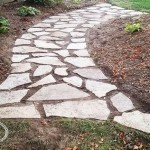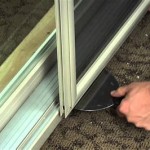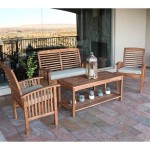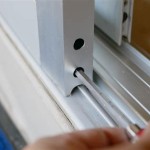Wooden Table Patio Furniture: A Guide to Selection, Care, and Longevity
Wooden table patio furniture offers a blend of aesthetic appeal and functionality, making it a popular choice for outdoor spaces. Its natural beauty complements various landscaping styles, while its inherent strength ensures durability. However, selecting the right type of wood, understanding proper care techniques, and knowing how to extend the furniture's lifespan are crucial to maximizing its value and enjoyment.
Types of Wood Used in Patio Tables
The type of wood significantly impacts the durability, maintenance requirements, and overall cost of a wooden patio table. Different wood species possess unique characteristics that determine their suitability for outdoor environments. Hardwoods are generally more durable and weather-resistant than softwoods, but they also tend to be more expensive. Understanding these differences is essential for making an informed purchase decision.
Teak is a highly prized hardwood known for its exceptional resistance to rot, decay, and insects. Its high oil content naturally protects it from moisture damage, making it ideal for outdoor use even in harsh climates. Teak furniture can last for decades with minimal maintenance, although it will naturally weather to a silvery-gray patina over time. The density of teak also contributes to its stability and resistance to warping or cracking.
Cedar is another popular choice for patio furniture, valued for its aromatic scent and natural resistance to insects and decay. While not as dense or durable as teak, cedar is still a relatively strong wood that can withstand exposure to the elements. It is often more affordable than teak, making it a good option for those seeking a balance between quality and price. Cedar requires periodic sealing or staining to maintain its appearance and protect it from moisture absorption.
Acacia is a hardwood often used as a more affordable alternative to teak. It possesses a rich, warm color and a distinct grain pattern. Acacia is relatively durable and resistant to rot, but it is not as naturally water-resistant as teak or cedar. Therefore, acacia patio tables typically require regular sealing or oiling to prevent moisture damage and fading.
Eucalyptus is a fast-growing hardwood that is gaining popularity as a sustainable option for patio furniture. It is naturally resistant to insects and decay and can withstand exposure to the elements. Eucalyptus often has a reddish-brown hue and a smooth, even grain. While less expensive than teak, eucalyptus still provides good durability and aesthetic appeal. Regular application of a wood preservative or oil is recommended to maintain its color and protect it from weathering.
Pine, a softwood, is a less expensive option, but it requires significant treatment to be suitable for outdoor use. Untreated pine is highly susceptible to rot, decay, and insect infestation. Pine patio tables are typically pressure-treated with chemicals to enhance their resistance to moisture and pests. However, even with treatment, pine furniture may require more frequent maintenance and may not last as long as hardwood options. It is essential to choose pressure-treated pine that is specifically designed for outdoor use.
Factors to Consider When Choosing a Wooden Patio Table
Beyond the type of wood, several other factors should be considered when selecting a wooden patio table. The size and shape of the table should be appropriate for the available space and the intended use. The overall design and style should complement the existing patio furniture and landscaping. Furthermore, the construction quality and hardware used can significantly impact the table's stability and longevity.
The size of the patio table should be proportionate to the size of the patio or deck. A large table can overwhelm a small space, while a small table may not provide enough surface area for dining or entertaining. Consider the number of people who will typically be using the table and the activities that will be taking place on it. Measure the available space carefully and choose a table that fits comfortably without obstructing movement.
The shape of the table can also influence its functionality and aesthetic appeal. Rectangular tables are a classic choice for formal dining, while round tables are often preferred for more casual gatherings. Square tables can be a good option for smaller spaces, and oval tables can add a touch of elegance. Consider the overall shape of the patio and choose a table shape that complements the existing architecture and landscaping.
The design and style of the patio table should harmonize with the surrounding environment. Choose a table that complements the existing patio furniture and reflects your personal taste. Consider the color, texture, and overall aesthetic of the space. A rustic wooden table may be a good choice for a natural, informal garden, while a sleek, modern table may be more appropriate for a contemporary outdoor setting. Look for tables with details that coordinate with other elements of the patio, such as cushions, planters, and lighting fixtures.
The construction quality is a critical factor in determining the durability and stability of a wooden patio table. Look for tables that are made with sturdy joinery and solid wood components. Avoid tables that are made with thin or flimsy materials. Check the connections between the legs and the tabletop to ensure that they are strong and secure. Pay attention to the hardware used, such as screws, bolts, and hinges. High-quality hardware will resist rust and corrosion, ensuring that the table remains stable and functional for years to come.
The finish applied to a wooden patio table can significantly impact its appearance and protection. Consider the type of finish that is appropriate for the type of wood and the desired aesthetic. Common finishes include sealants, stains, paints, and oils. Sealants provide a clear protective layer that prevents moisture absorption and helps to maintain the natural color of the wood. Stains add color to the wood while still allowing the grain to show through. Paints provide a solid color finish that can be customized to match the surrounding environment. Oils nourish the wood and help to prevent drying and cracking. Choose a finish that is specifically designed for outdoor use and that is resistant to fading, chipping, and peeling.
Maintaining and Protecting Wooden Patio Tables
Proper maintenance is essential for extending the lifespan and preserving the beauty of wooden patio tables. Regular cleaning, sealing, and storage can help to prevent damage from moisture, sunlight, and insects. The specific maintenance requirements will vary depending on the type of wood and the finish used, but some general guidelines apply to all wooden patio tables.
Regular cleaning is essential for removing dirt, dust, and debris that can accumulate on the surface of the table. Use a soft brush or cloth and a mild soap-and-water solution to clean the table. Avoid using harsh chemicals or abrasive cleaners, as these can damage the finish and the wood. Rinse the table thoroughly with clean water and allow it to dry completely before applying any sealant or oil. For stubborn stains, a specialized wood cleaner may be necessary, but always test it in an inconspicuous area first.
Sealing or oiling the table regularly is crucial for protecting it from moisture and UV damage. The frequency of sealing or oiling will depend on the type of wood and the climate. Teak, for example, may only need to be oiled once or twice a year, while other woods may require more frequent treatment. Choose a sealant or oil that is specifically designed for outdoor use and that is compatible with the type of wood. Apply the sealant or oil according to the manufacturer's instructions, ensuring that all surfaces are evenly coated.
Proper storage during the off-season is essential for preventing damage from harsh weather conditions. If possible, store the patio table indoors in a dry, well-ventilated area. If indoor storage is not available, cover the table with a waterproof cover to protect it from rain, snow, and sunlight. Ensure that the cover is breathable to prevent moisture buildup and mildew growth. Elevate the table slightly off the ground to allow for air circulation. Before storing the table, clean it thoroughly and apply a fresh coat of sealant or oil.
Addressing minor damage promptly can help to prevent it from escalating into more serious problems. Repair any cracks, chips, or scratches as soon as they are noticed. Use a wood filler or epoxy to fill small cracks and sand the area smooth. Reapply the finish to the repaired area to match the surrounding surface. Tighten any loose screws or bolts to maintain the table's stability. If the damage is extensive, it may be necessary to consult a professional furniture repair service.
Protecting wooden patio tables from excessive heat and direct sunlight can help to prevent fading, warping, and cracking. Use patio umbrellas or awnings to provide shade during the hottest part of the day. Avoid placing hot objects directly on the table surface. Use coasters or placemats to protect the table from spills and stains. Be mindful of the table's proximity to heat sources, such as grills or fire pits.
Controlling moisture is crucial for preventing rot and decay. Ensure that the patio table is properly drained and that water does not accumulate on the surface. Clean up spills promptly to prevent them from soaking into the wood. Avoid using harsh cleaning products that can strip away the natural oils and protective finishes. Regularly inspect the table for signs of moisture damage, such as discoloration, swelling, or soft spots. If moisture damage is detected, address it promptly to prevent further deterioration.

Garden And Patio Tables Up To 70 Off Beliani No

12 Ways To Wake Up Your Tired Outdoor Furniture Teak Patio Wood Wooden

Handmade Wooden Outdoor Furniture The Bespoke Carpentry Co

Rustic Outdoor Dining Table And Bench Reclaimed Solid Wood

Crafty Solutions Archives Pepper Design Blog Mesas De Madera Cocina Comedor

Outdoor Teak Dining Set Summit 15 Ft Infinity Table

Garden Furniture Sets Tables Benches Chairs Parasols Cushions Patio

How To Re Wooden Outdoor Furniture The Honeycomb Home

Reclaimed Wood And Iron Outdoor Table Two Sizes

Outdoor Dining Tables Sets Pottery Barn
Related Posts








